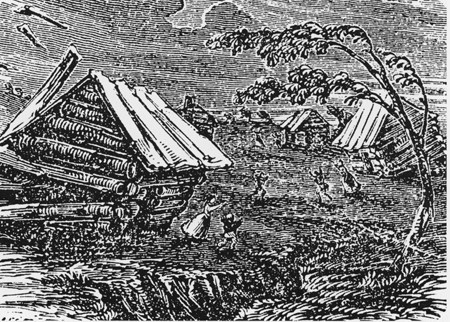By Dr. Curtis Varnell
Two huge events have done more than anything else to shape the history of Arkansas; The Civil War and the occurrence of the New Madrid Earthquake of 1811-12. Much more is known of the Civil War and the bitterness, destruction, and death it engendered than is known of the enduring desolation and hardships created by the earthquake. Arkansas, just recently brought into the Union as a result of the Louisiana purchase, was sparsely populated so there was little loss of property and life, but the long-lasting effects of the quake was to change the entire history of the state.


The first tremors hit in late 1811 and was followed by several other quakes within the next few months. Although the 1906 San Francisco earthquake is the one most discussed in America, the New Madrid was larger and more extensive in nature. The quake caused the ground to rise and fall, opening deep cracks into the earth and setting off huge landslides. Water, sand, and gravel erupted from fissures deep within the earth, shooting into the air like geysers. From Cairo, Illinois, to Memphis, Crowley’s Ridge, and into Tennessee the land buckled and shifted, forming lakes and swamps in one area while pushing land into uplifted areas nearby. Large waves were generated on the Mississippi River, creating a waterfall flowing northward. Keelboats and small schooners were washed miles upriver, leaving a path of destruction in its wake.
Eyewitness accounts described the terror and carnage created by the quake. “Our family all were sleeping in a log cabin, my father leaped out of bed crying aloud, the Indians are on the house, only to discover it was far worse than the Indians. The cattle came running home bellowing with fear. Our house cracked and quivered so we thought it would fall to the ground,” stated John Reynolds, who later became the 4th governor of Illinois. John Bradbury, a worker on a boat stated, “Perpendicular banks above and below us, began to fall into the river in vast masses. I could hear the crash of falling trees and the screaming of water fowl. The noise was inconceivably loud and terrific.” Agitated by the estimated 7.5 magnitude quake, church bells as far away as North Carolina and Washington D.C. clanged.
The region most seriously affected were the sunken lands, fissures, and sinks of the delta regions. Eastern Arkansas was devastated. Lake St. Francis in eastern Arkansas, some 30 miles long and over a mile wide in places, was created when the St. Francis River shifted due to the earthquake. Sinks, swamps, bayou’s, and downed timber made much of the delta virtually unpassable to overland travel. Damage to the region was so severe that William Clark, famous for his travels with Meriwether Lewis and in 1812, governor of the Louisiana Territory, became the first to request federal relief to assist the people of the region.
As late as 1836, a group of Indian on the Trail of Tear arrived in Memphis with all of their belongings. Women were shipped across the delta up the Arkansas River by boat while their men-folk and animals travelled by land. The women arrived in Little Rock and waited. Two-weeks later, a rescue group back-tracked down the river and found the men near the present day town of Lonoke. The animals and men suffered from malaria, foot rot, and other illness brought on by the trek over the sunken lands.
Travel through much of the region was difficult at best, impossible for much of the year. While rail systems were developing elsewhere, Arkansas lagged behind with less than 30 miles of track laid as the war began in 1861.
In 1849 the great California gold rush began. The most logical way west would have been from Memphis, across Arkansas, and then west following what is now interstate 40. In that scenario, the jump-off place to the west would have been Fort Smith and perhaps the Gateway Arch would have been located on the banks of the Arkansas River.
The people of the delta and Eastern Arkansas live with the possibility of future earthquakes. They mid-point of the cycle for the New Madrid quake is about 200 years. Let’s see, 1812, 1912, 2012—- we live with the very real possibility of future earthquakes in Arkansas.
